JOJ Nursing &Health Care Juniper Publishers
Authored by Sisay Shewasinad*
Abstract
Patient satisfaction could be a result of each patient’s perception of the care designed for that patient to eliminate his/her problems. Patient satisfaction, in most countries, is considered to be an indicator of the quality of healthcare and an important component of the care. The aim of this study is to assess adult patient satisfaction and associated factors with nursing care among admitted patient in medical, surgical and obstetrics and gynecology ward. The study was utilized an institutional based cross-sectional study design that employed both quantitative and qualitative data collection methods. Study participants were selected by random sampling technique. The data was collected through face to face interview using structured questionnaires. Both bivariate and multivariate logistic regression analysis was done. Overall proportion of adult inpatient satisfaction among the respondents was 184 (61.3%) and 116(38.7%) were dissatisfied with the nursing health care service provided at the inpatient. concluded that, adult inpatient satisfaction related to the health care services provided by the nurses is inadequate.
Keywords:Patient; Satisfaction; Nursing care
Introduction
Despite the availability of a wide range of quantitative and qualitative studies on patient satisfaction, there appears to be a lack of consensus on this issue from different investigators. Recognizing that patient satisfaction has something to do with how nursing care is received and appreciated, this study will look to find out exactly what nursing care factors contribute to patient satisfaction in hospitals. The problem is that, for the most part, it is not known what matters affect patients’ satisfaction with nursing care. Why is it that some patients are satisfied with nursing care while others are not? There is a need to find out this from the patients’ perspectives, as well as their hospital experiences, views and needs. This lack of a consensus on what constitutes patient satisfaction with nursing care poses a major challenge for the health services. Key performance indicators are used to monitor and evaluate the effectiveness and efficiencies of organizations and their staff. Patient satisfaction is one of the essential indicators for healthcare service improvement. From that view, the patient satisfaction survey is an instrument in monitoring health care delivery of a hospital in relation to nursing care. Specifically, inpatient department is the first-line healthcare service provided to patients [1]. Therefore, the quality of care will indicate the quality of service of the hospital as perceived by the patients regarding various factors. this study also initiates further research in the area.
Objective
General Objective: To assess adult patient satisfaction and associated factors with nursing care among admitted patient in medical, surgical and obstetrics and gynecology ward of MAGH, Bonga and Tepi Hospitals, 2016.
Specific Objectives: To determine the satisfaction levels of admitted adult patient in medical, surgical and obstetrics and gynecology wards in selected hospitals, 2016
To assess determinant factor affecting admitted adult patient satisfaction in medical, surgical and obstetrics and gynecology wards in selected hospitals, 2016 [2,3].
Methodology
Study Area and Study Period
The study was conducted in selected health institutions MTUTH, Bonga and Tepi hospitals southwestern Ethiopia from February 1st to May last.
Study Design
The study was utilized an institutional based cross-sectional study design that employed both quantitative and qualitative data collection methods to assess adult patient satisfaction and associated factors with nursing care among admitted patient in selected hospitals [4-6].
Source Population
The source population were all admitted adult patients in medical, surgical and obstetrics and gynecology ward of MTUTH, Bonga and Tepi hospitals who have at least two days admission [7].
Study Population
Study population were sampled admitted adult patient in selected health institution in medical, surgical and obstetrics and gynecology ward of MTUTH, Bonga and Tepi hospitals who have at least two days admission [8-10].
Eligibility Criteria
Inclusion Criteria: All admitted adult patients whose age is greater than 18 years and who have at least two days admission in medical, surgical and obstetrics and gynecology ward from selected health institution during the study period [11].
Exclusion Criteria: Admitted adult patients who were unable to participate due to mental illness and other causes were excluded.
Sample Size Determination
The sample size was determined by using single population proportion formula. The following assumptions were made, marginal error (W) that will be tolerated in either sides of the true proportion to be 5%, and using 95% confidence level and adding 10% to compensate for non responses and the proportion of patient satisfaction with nursing care (P), 77% from research done at Jimma University Specialized Hospital [12-14].

By assuming non-response rate 10%, the total sample size will be:
Sample size = (272 x10%) + 272 = 300
Antifungal resistance
For qualitative part: participants were selected purposely from chronically admitted patients. The samples were considered as sufficient, when the information we got will get saturated.
Sampling Technique
Quantitative Part: Study participants were selected by random sampling technique (non replaced lottery method). First the sample was determined depends up on the patient flow to each wards of the selected hospitals then the total number of sample size was proportionally allocated to each wards selected hospitals depending up on the patient flow [15,16].
Qualitative Part: Key informants like chronically admitted patient were selected using purposive sampling for in-depth interview. The sample was considered sufficient, when the information we got were got saturated [17].
Data Collection Technique and Tools
Data on patient satisfaction levels were collected through interview using standard questionnaire/ tool, the Newcastle Scale of Satisfaction with nursing /NSSN/, is a 19-item scale assessing patient satisfaction with nursing care service received in inpatient. The scale includes statements about aspects of the nursing care services provided at admitted patients which respondents are asked to rate them on a Likert scale ranging from 1 to 5, where one is “poor” and 5 is “excellent.” The scale is scored by summing each item. Higher scores indicate greater satisfaction with nursing care services, while lower scores indicate less satisfaction. Nine Bsc Nurses from health centers were involved in data collections who were speaker of Amharic and local language. The principal investigators were supervisors. For qualitative, the data collection was employed with in depth interview through probing questions. Tape recorder was employed to the area where in depth interview was conducted and note and observation also were undertaken. Chronically admitted patient (who will not be involved in quantitative survey) were involved [18-20].
Variables
Dependant Variable: Patient satisfaction
Independent Variables: Socio-Demographic characteristics: - age of the patient, sex of the patient, marital status, educational status, economic status (income), place of resident and occupation [21-23].
Data Quality Assurance
Interviewers were trained on methods of data collection. Questionnaires were checked on daily basis for completeness during data collection and were cleaned and coded before data entry. Data analysis was started by sorting and performing quality control checkup. Data was checked to ensure that all the information were properly collected and recorded. Before and during data processing the information was checked for completeness and internal consistency. The questionnaire was pre-tested before data collection, pre-testing was done in same health facility, but out of the selected wards. For qualitative part proper information was provided for every participant about the importance of the study which helps us to elicit more information from the interviewee [24].
Data Processing and Analysis
For quantitative data processing, master sheet or template was prepared and the data was entered, categorized, coded, and summarized using EPI 6 and transformed to SPSS version 20.00 in the computer for further analysis. Frequency and proportion were computed for description of study population in relation to socio demographic and other relevant variable (age, marital status). Both bivariate and multivariate logistic regression analysis were done to see the association of each categories of each variable with the outcome variable. Significances were checked at 95% CI in binary logistic regression. Variables with p<0.25 in binary logistic regression analysis were entered in multivariate logistic regression analysis to control for potential confounding variables [25-27].
Ethical Consideration
Permission letters were obtained from research and community service directorate of MTU. All the study participants were informed about the purpose of the study. Prior to data collection, verbal consent were obtained from the study participants. All information that was obtained from the individual was treated confidentially. Permission to audio-record for the interview was also obtained. Participants were not face any harm and were not receive any financial incentive for participating and it was solely on voluntary based [28].
Dissemination of Result
The result of the study will be communicated to relevant bodies including to MTU and the selected health sectors. Furthermore, all attempts will be made to present the findings to scientific conference and attempt will be made to publish the finding in reputable journal.
Result
Quantitative Findings
A total of 300 eligible patients were interviewed from MTUTH, Bonga Hospital and Tepi Hospital with 100% response rate [29].
Socio-Demographic Characteristics of the Respondents
Table 1 Socio-demographic characteristics of the respondents (n=300) in MTUTH, Bonga Hospital and Tepi Hospital, Bench Maji Zone, South West Ethiopia, June 2016. Overall quality of nursing care provided in inpatient ward with the respective to the patient satisfaction indicated that most of the inpatient about 53.3 % of them has replied that there is fairly satisfaction related to the overall quality of nursing care provided in the inpatient ward (Figure 1). Adult patient satisfaction in the three selected hospital showed that most of the respondents about 61.3% of the total indicated that they are dissatisfied and the rest of the respondents 38.7% of the respondents are satisfied (Figure 2) [30-34].
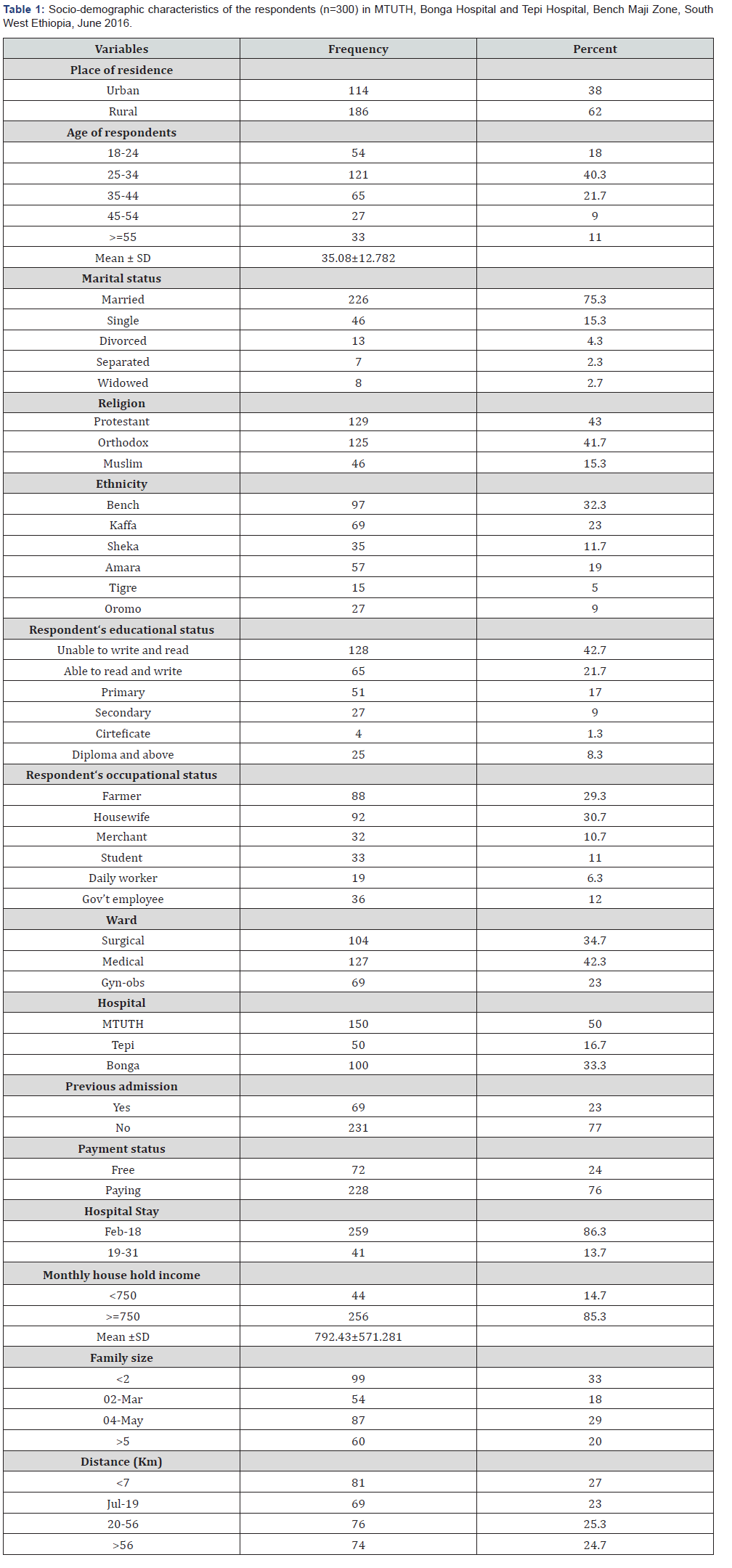
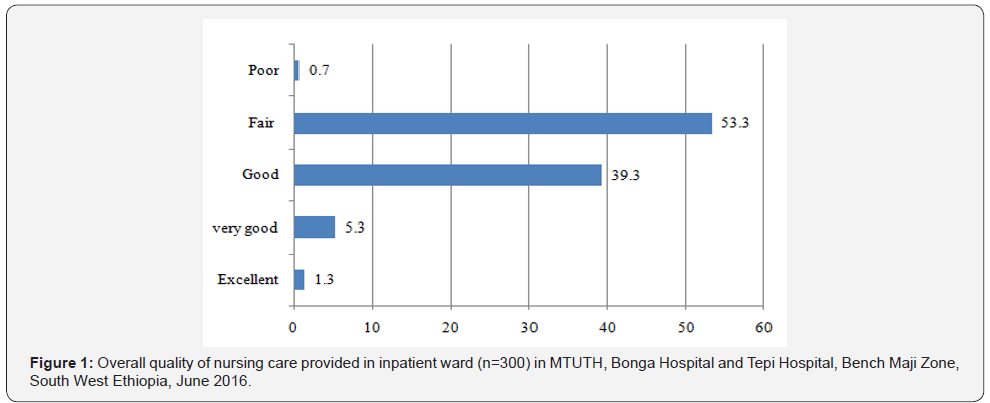
Determinant Factors Related to Socio Demographic Variables Associated with the Inpatients Satisfaction
Qualitative Findings. Quality of nursing health care services and factors which influence it. The majority of the interviewee reflected mixing of opinions with no clear determination of the quality of nursing health care services provided in the inpatient wards. One of the interviewee from the inpatient said, “As to me the quality of nursing health care services in this inpatient ward is not that much attractive. Because as you have seen here, there is no enough room for patients and patients are obliged to admit at the hospital corridor and nurses therefore are not interested or volunteer to bring bed linen and find out alternative solution even were not interested or motivated to understand our pain.” (A 52 years of old male inpatient from MTUTH, surgical ward) Key attributes of patient-satisfaction in nursing health care services Regarding to the key attributes of patient satisfaction related to the nursing health care services one of the interviewee from the inpatient has replied, “There are some problems in which I was not satisfied even though there is also good nursing health care services (Table 2). For instance, things which makes me dissatisfied includes that nurses in this inpatient ward are not that much cooperative because the way that they respond to our question is not attractive and even they didn’t come as quickly as possible when we call them for help (Table 3). There are some nurses who provide us different services by wearing the same personal protecting equipments like gloves and especially this makes me discomfort when they touch me and administer medication with the gloves which were previously used. Additionally, I have appreciated one main problem here in this ward which is there are some nurses who lacks confidence related to medication administration.” (A 47 years of old male inpatient from MTUTH, medical ward) [35-39].
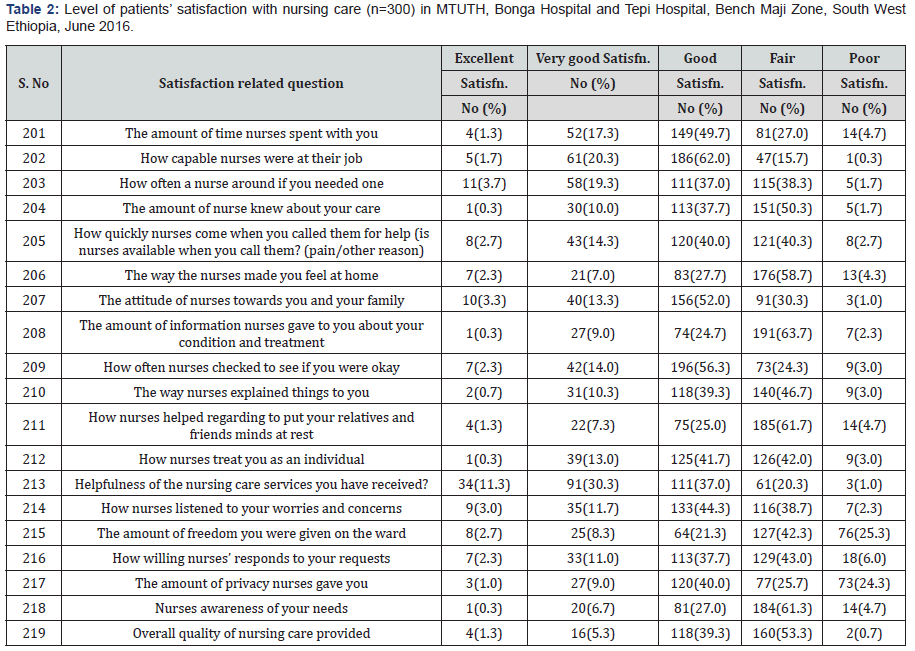
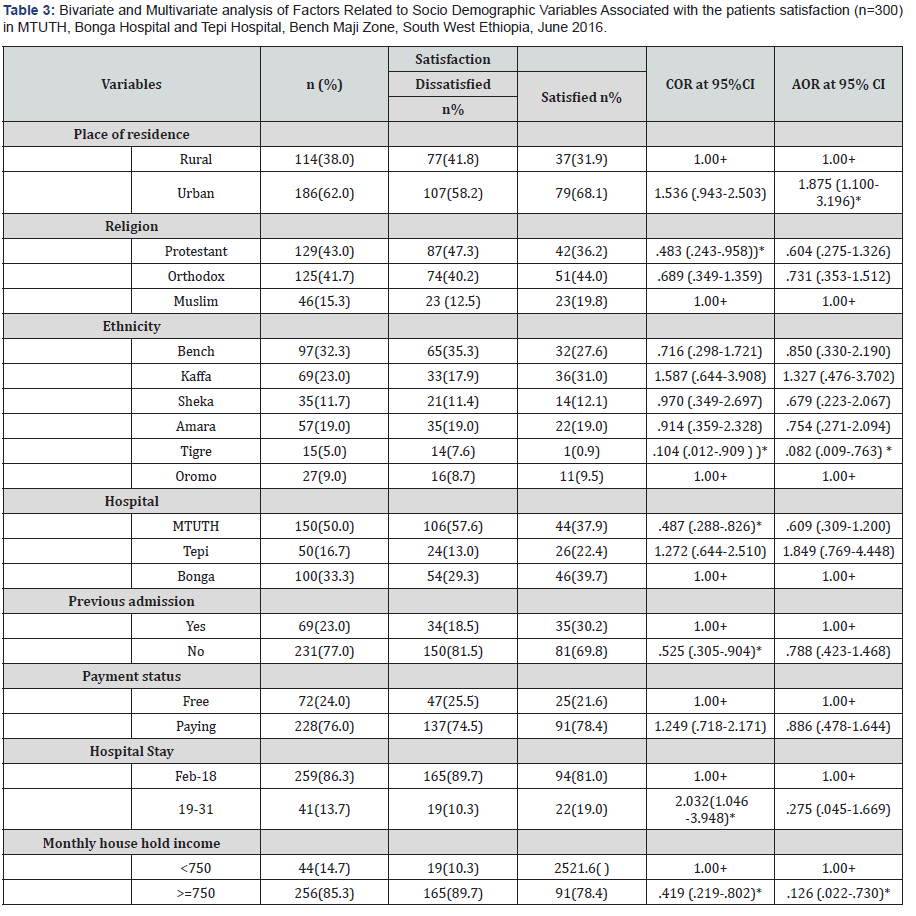
Discussion
Patient satisfaction has become an important indicator to measure the quality of care rendered to the patients while in hospital. The finding of this study showed that the overall satisfaction level of the patients with the nursing care services at Mizan-Tepi university teaching hospital, Tepi and Bonga Hospitals was 116(38.7%). This finding is lower than a study conducted at Jimma University Specialized Hospital revealed that the overall satisfaction level of the clients with the services was 77.0 % [40] and other study conducted at a Mozambique Hospital, Amhara region and Tigray zonal hospitals revealed that the overall satisfaction level of the clients with the services was 55%, 50% and 43.60% respectively [41-43]. The possible explanation for the observed difference could be the difference in socio-demographic characteristics of participants and upgrading different nurses to the next level. Among a number of socio-demographic and patient related factors included in this study, only few were identified as significant predictors of the patients’ overall satisfaction with nursing care services in the multivariate analysis [45-52]. These include place of resident and monthly income were found to be statistically significant predictors of patients’ satisfaction. In this study respondents who lived in urban were almost two times more likely to be satisfied with the nursing care given in the inpatients than who were rural residence (AOR = 1.875, 95% CI = [1.100, 3.196]), and respondents whose household income was >=750 Ethiopian birr were less likely to be satisfied with the nursing care in the inpatients than who were <750 Ethiopia birr (AOR = .126, 95% CI = [.022, .730]) it was incongruent with study done at Addis Ababa Black Lion Hospital multivariate analysis result showed that female (95%CI, AOR:.36(0.14, 0.93)) were more satisfied than male patients. Age=>50 years (95%CI, AOR:3.78(1.35, 10.56)) were less likely to be satisfied than patients age < 50 years and other study showed that the length of stay as well as previous experiences during hospitalizations also influenced patient satisfaction The length of stay as well as previous experiences during hospitalizations also influenced patient satisfaction [53].
To
Know More About JOJ Nursing & Health Care Please Click on: https://juniperpublishers.com/jojnhc/index.php
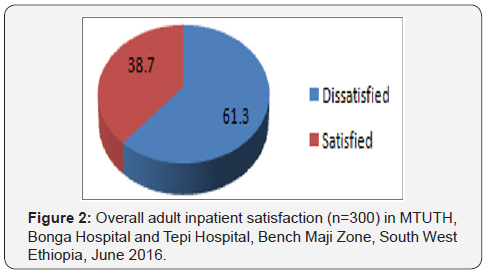




No comments:
Post a Comment